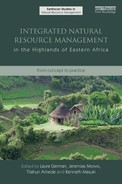PREFACE
This book represents an ambitious effort to document over ten years of research, methodological innovation, and lessons learning in AHI through reflections by the protagonists themselves—AHI site teams and partners involved in innovating to enhance the impact orientation of research. It attempts to summarize the experiences of farmers, researchers, and development workers, and policy and decision-makers who have interacted with AHI on the theme of Integrated Natural Resource Management in the humid highlands of eastern Africa. It aims both to raise awareness of the crucial importance of methods or “approaches” in the outcomes derived from research and development work, and to distill lessons learned on “what works, where, and why.” The book therefore is enriched with examples and case studies from five benchmark sites whose variability provides the reader with an in-depth knowledge of the complexities of natural resource management (NRM) in agro-ecosystems that play an important role in the rural economy of the region. The struggle to achieve sustainable agricultural development in challenging environments is a difficult one, and can only be effectively achieved through combined efforts and commitment of individuals and institutions with complementary roles.
The book is organized into six chapters. Chapter 1 gives an overview of INRM as a concept and the birth and evolution of AHI, including the methodological framework through which innovations were developed and tested and its results. Chapter 2 provides an overview of farm-level methodological innovations oriented towards participatory intensification and diversification of smallholder farming systems for optimal system productivity (economic, social, and ecological). Chapter 3 summarizes AHI experiences with a set of approaches employed to operationalize participatory watershed management through an integrated lens which looks not only at soil and water but at a wider set of system components and interations. Chapter 4 explores lessons learned to date on methods and approaches for participatory landscape governance, exploring how processes that cut across farm boundaries, involve trade-offs between different land users or require collective action may be addressed effectively and equitably. Chapter 5 explores the role of district level institutions and cross-scale linkages in supporting grassroots development and conservation initiatives, including improved coordination and better support to local livelihood priorities and bottom-up governance reforms. Chapter 6 explores methods and approaches for scaling up and institutionalizing integrated natural resource management innovations (e.g., those presented in earlier chapters), as well as approaches for self-led institutional change that can institutionalize the process of methodological innovation and impact-oriented research.
